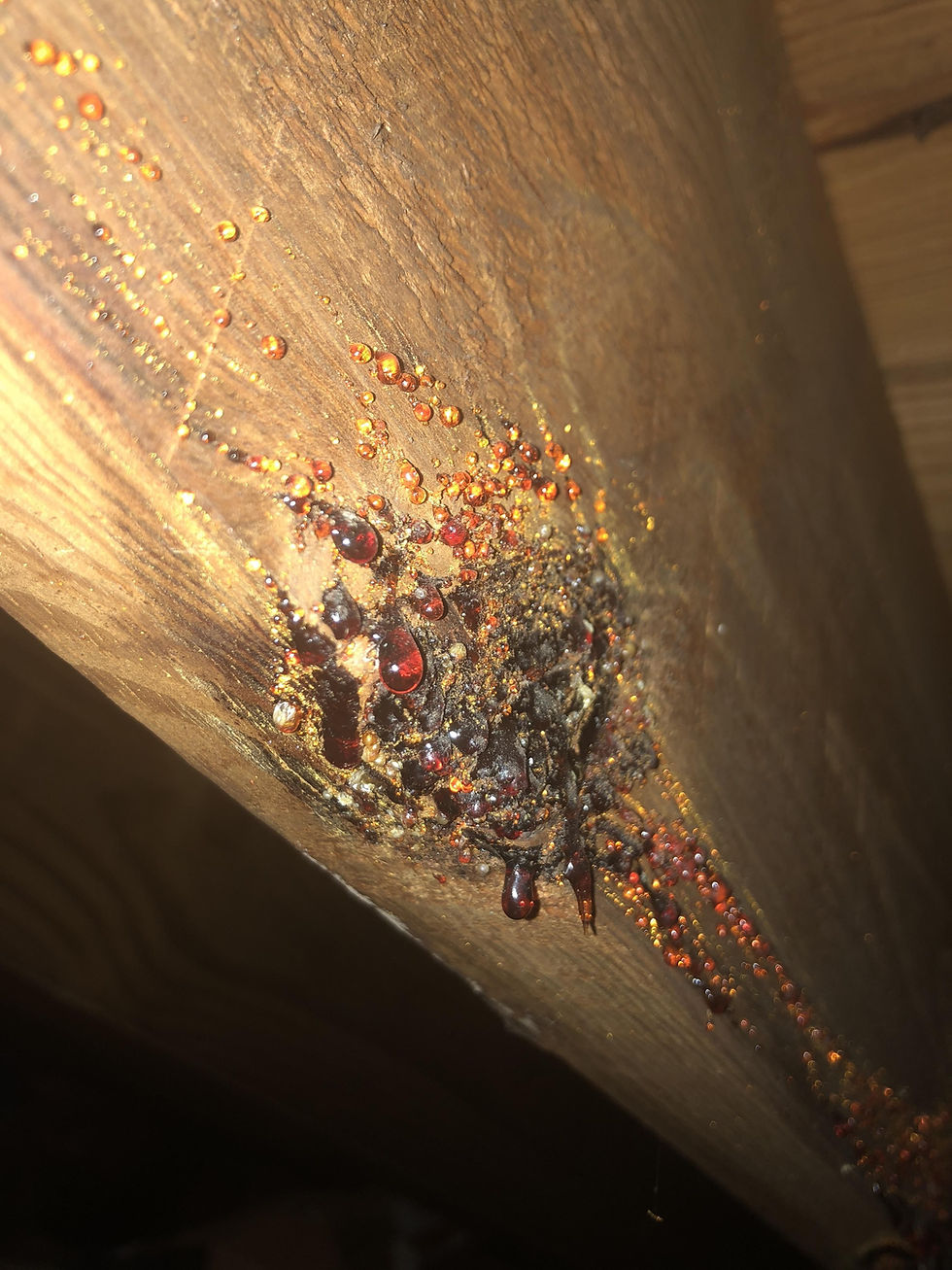Causes of wood sap on attic beams

During the really hot months of the year the temperature in your attic increases drastically. When wood is exposed to high heat some issues may occur. So knowing the consequences of high heat and how to prevent it is important for both your wallet and home.
What is attic Ambering
Attic ambering is the process of rafters and or beams in the attic that have sap leak out. Tree sap contains various chemical components that we will not cover here but in relation to saps function a good comparison to compare sap to is blood. When a tree is alive the sap carries nutrients throughout the trees. When a tree is damaged the sap may bleed or leak out.
As the excessive heat enters the attic, over time the beams tend to leak out. If you see golden colored crystals in your attic you have discovered attic ambering.
What does wood sap on rafters look like?
Wood sap on rafters can exist in different forms. Ambering starts with liquid drops leaking out of the beams . The liquid droplets range in color from dark red, amber to different shades of yellow. Over time the sap may harden and crystallize in the shape of a tear drop.
What happens to wood that causes it to sweat?
Just like humans HEAT is the main factor that causes the beams to sweat. As the heat rises the internal molecules tend to move around and bump into each other causing internal pressure. As a result to decrease the pressure those molecules tend to move outward to decrease the pressure. The beam begins to sweat which results in ambering.

What are the biggest set backs of wood sap in attic?
The sap itself consist of sugar and water. The sap may attract dirt and dust. Additionally unwanted insects and pests may be attracted to the sap.
How can attic sap be prevented?
To prevent ambering the attic needs to be insulated and ventilated properly. This prevents the attic from excessively heating up.
How do you remove the sap?
If the sap has not hardened try using oil soap to remove excessive residue. Warm water and a short brush works well. Additionally acetone can help remove residue. For hardened sap a sharp wood chisel is a good choice to scrape off the crystals.
Ambering may not be a big issue by itself but may indicate improper ventilation or insulation within the attic. Your local home inspector will check for signs of improper insulation and or ventilation if ambering is discovered in the attic.
The most common and best form of ventilation setup is an attic that contains lower soffit vents & a ridge vent OR Static mushroom vents.
If your roof contains soffits and a ridge vent and you believe you do do not have adequate ventilation due to the observation of wood sap on rafters, condensation and or wet to the touch on the osb/plywood and or mold in the attic, you may need to further look into the current ventilation system and investigate potential problems.
Soffits may be clogged: Your soffit vents may be clogged with insulation. To inspect the soffit area enter your attic and check to see if down in the eaves area there is a 2-3 " clearance between the insulation and the roofs underlayment. You should be able to see a little day light during the day down near the eaves. If you cannot see a hint of daylight you may need to unclog your soffit vents. To unclog your soffit vents you will need to pull back and or clear insulation and install attic baffles to prevent the insulation from shifting back and clogging the soffit vent. After you pull back the insulation you will need to install the attic baffles to prevent the insulation from clogging the eaves. Attic baffles are important as they prevent the insulation from clogging your soffit vents once again. Attic baffles are very easy to install. A simple staple gun and stapes will do the trick.

AccuVent is a great product at a reasonable price. Here are some of the specs:
AccuVent Original Attic Soffit Vent Systems fits 22.5 inch x 41 inch soffit areas (24″ o.c.).
Designed specifically for traditional ceiling applications with either blown-in or batting type insulation
Easy to install with only 6-8 staples! User-friendly perforated tear strip for width adjust-ability.
Prevents wind washing, drifting of insulation, and helps to prevent mold and mildew growth!
100% recycled flame retardant plastic that meets the new EnergyStar Thermal Bypass Checklist requirements.
Ridge Vent May have collapsed and or contains insufficient clearance:
Generally speaking, attics should have two forms of ventilation. One is the soffit vents and the second is a ridge vent. We recommend the Cobra ridge vent. Check out the installation video below.
You may want to consult with a qualified contractor when replacing and or installing a ridge vent. This may not be an easy job for a beginner.
Cobra Ridge vent is one of the most commonly used, well priced and overall best bang for your buck ridge vent. Remember to measure the length of the ridge vent on your home to make sure you are ordering a sufficient amount of material.
Correcting attic ventilation may help with your lowering energy bill as far as heating and cooling, prevent pre-mature failure of shingles and or underlayment and prevent mold growth. Attic ambering may in itself be harmless it may indicate other potential attic issues that can be costly repairs if the ventilation problem is not corrected.
The Author Adam Clark is the owner and operator of Shield Guard Home Inspections. Adam Clark is a local Home Inspector located in Albany NY that has performed over 8000 Inspections Phone: (518) 720-7152
The information provided is for informational and educational purposes only.






















